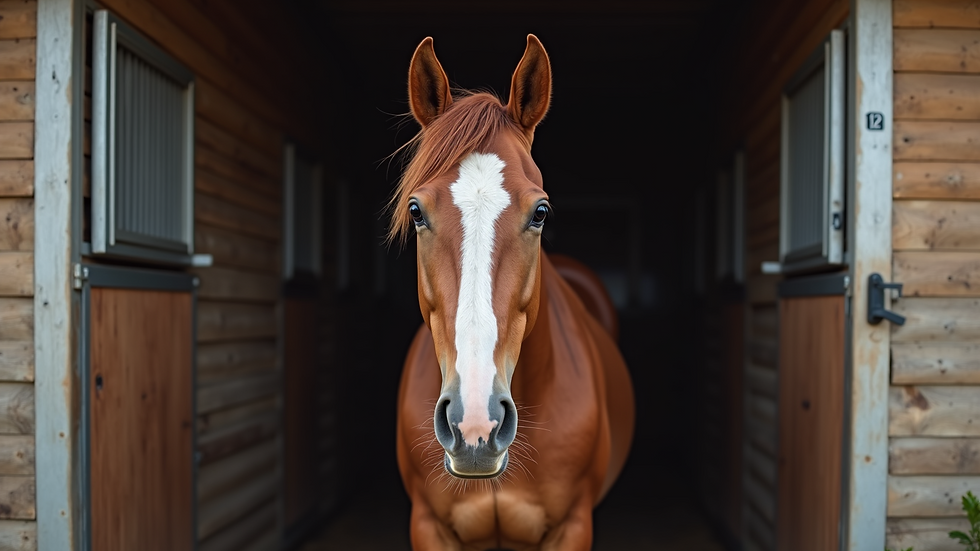What to Expect During Your Horse's Initial Assessment: A Comprehensive Guide
- reycam2003
- May 11
- 3 min read
When it comes to your horse's health, the initial assessment is a crucial step. This first appointment not only lays the groundwork for treatment but also establishes a strong foundation for ongoing care. Whether you're a lifelong horse owner or new to the equine world, knowing what happens during this important evaluation can help set you and your horse up for success.
Static and Dynamic Assessment
The assessment kicks off with a static and dynamic evaluation of your horse.
During the static assessment, the veterinarian or physiotherapist will observe your horse while it is standing still. They check the horse's posture and demeanor. Is your horse relaxed or stiff? Is it bearing weight evenly on all four legs? Noticing these changes can provide valuable insights into any underlying issues.

Next comes the dynamic assessment, which involves your horse walking and trotting in a straight line. Here, the evaluator pays close attention to the horse's gait. Does it move fluidly, or is there a hitch? Observing any irregularities can help pinpoint issues that need to be addressed.
Together, these assessments give the practitioner crucial information about your horse's movement and behavior, guiding the treatment plan moving forward.
Palpation
Palpation is the next essential part of the assessment. This hands-on approach allows the practitioner to physically feel the horse’s body for abnormalities or tightness.
The practitioner carefully checks various muscle groups and joints for any tension, soreness, or swelling. For instance, if your horse reacts noticeably when the back muscle is touched, it could signal pain that needs further investigation.

This step is not just about identifying issues; it also helps set a health baseline. By comparing findings over time, you and your veterinarian can measure how well your horse responds to treatment.
Range of Motion (ROM) Testing
Once palpation is complete, the next step is assessing your horse's Range of Motion (ROM). Joint flexibility and movement are vital for your horse’s overall health and performance.
To evaluate ROM, the practitioner gently moves each limb through its full range. They pay attention to any restrictions or discomfort during these movements. For example, if your horse resists flexing a specific joint, it could suggest problems like arthritis or injuries.
Treatment as Necessary
Based on the assessment findings, various treatment options may be recommended. The initial assessment may lead to multiple therapeutic interventions tailored to your horse's unique needs.
Manual Therapies and Therapeutic Exercises
Manual therapies, such as massage, can relieve muscle tension and improve blood circulation. Studies show that regular massage can enhance recovery in performance horses and reduce chronic pain in others.
Therapeutic exercises also play a significant role in rehabilitation, aiming to improve strength and flexibility. Your practitioner may provide you with a personalized exercise plan you can implement regularly. This proactive approach can lead to measurable improvements in your horse's condition.
Electrotherapy
Electrotherapy modalities, like TENS (Transcutaneous Electrical Nerve Stimulation), may also be suggested. This non-invasive technique applies electrical stimulation to reduce pain and improve muscle function.
The Length of the Appointment
An initial assessment appointment typically lasts around 90 minutes. This time allows for a thorough evaluation and treatment options to be discussed. Ensuring every facet of your horse's health is scrutinized helps prevent overlooking vital details.
Creating an effective treatment plan is key to your horse's well-being. Consistent alignment between your horse's needs and the approaches taken can lead to significant improvements over time.
Final Thoughts
Understanding what to expect during your horse's initial assessment is crucial for any owner. From the static and dynamic evaluations to palpation and treatment options, each component plays a vital role in promoting your horse’s health.
This first visit aims not only to identify current issues but also to establish a path for necessary interventions. Being well-informed empowers you with the tools you need for ongoing care.
By actively participating in the assessment process, you foster a collaborative relationship with your veterinarian. This teamwork is essential to ensure the best care for your horse. With a comprehensive, informed approach, you will help your horse remain healthy, happy, and ready for life's adventures.




Comments